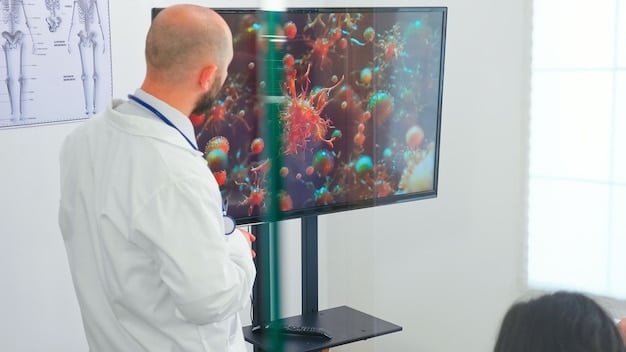Will AI Cut Cancer Costs by 20% in the US by 2026? A Personalized Medicine Revolution

AI-driven personalized medicine holds the potential to significantly reduce cancer treatment costs in the US, but whether it will achieve a 20% reduction by 2026 depends on factors like technological advancements, regulatory approvals, and widespread adoption.
Can artificial intelligence truly revolutionize cancer treatment and deliver significant cost savings? The prospect of AI-driven personalized medicine reducing cancer treatment costs by 20% in the US by 2026 is generating significant discussion, but is it realistic? Let’s delve into the factors driving this potential transformation and the hurdles that lie ahead.
The Promise of AI in Personalized Cancer Treatment
Personalized medicine, tailoring treatment to an individual’s unique genetic and molecular profile, is already transforming cancer care. AI is poised to accelerate this revolution, offering powerful tools to analyze vast datasets and identify optimal treatment strategies.
But how can AI drive down costs?
Precision Diagnostics and Targeted Therapies
AI algorithms can analyze medical images (CT scans, MRIs, PET scans) with greater speed and accuracy than humans, leading to earlier and more precise diagnoses. This, in turn, enables the selection of targeted therapies that are more effective and less toxic than traditional chemotherapy.
Predicting Treatment Response
AI can predict how a patient will respond to a particular treatment based on their genetic makeup, tumor characteristics, and other clinical data. This allows oncologists to avoid ineffective treatments, reducing unnecessary costs and side effects.
- Improved Diagnostic Accuracy: AI enhances the precision of cancer detection and staging, leading to earlier and more effective interventions.
- Optimized Treatment Selection: AI algorithms identify the most suitable therapies for individual patients, minimizing the use of ineffective and costly treatments.
- Reduced Adverse Effects: Personalized treatment plans guided by AI decrease the incidence of severe side effects, lowering the need for supportive care and hospitalization.
- Streamlined Clinical Trials: AI accelerates the identification of eligible patients for clinical trials, facilitating quicker and more efficient drug development processes.
The implementation of AI in personalized cancer treatment holds considerable promise for enhancing patient outcomes and streamlining healthcare delivery. By leveraging AI’s analytical capabilities, medical professionals can make more informed decisions, leading to more effective treatments and cost optimization.

Factors Influencing Cost Reduction
While the potential is clear, several factors will determine whether AI can achieve a 20% reduction in cancer treatment costs by 2026. These include the pace of technological development, regulatory hurdles, and the willingness of healthcare providers to adopt new technologies.
Let’s break down the key elements involved:
Development and Validation of AI Algorithms
AI algorithms require extensive training on large datasets of clinical data. Ensuring the accuracy, reliability, and generalizability of these algorithms is crucial. Rigorous validation studies are needed to demonstrate their clinical utility and cost-effectiveness.
Regulatory Approval and Reimbursement
AI-based diagnostic and treatment tools must be approved by regulatory agencies like the FDA. Obtaining regulatory approval can be a lengthy and expensive process. Furthermore, even if approved, these tools must be reimbursed by insurance companies for widespread adoption.
Integration into Clinical Practice
Integrating AI into clinical workflows requires significant changes in how cancer care is delivered. Healthcare providers need to be trained on how to use these tools effectively, and electronic health record systems need to be updated to accommodate AI-generated insights.
Widespread adoption of AI in personalized cancer treatment is also contingent on addressing privacy and security concerns related to patient data. Protecting patient data from unauthorized access is essential for maintaining trust and ensuring the ethical use of AI in healthcare.

Potential Obstacles and Challenges
Despite the optimistic outlook, several obstacles could hinder the widespread adoption of AI in personalized cancer treatment and prevent the achievement of a 20% cost reduction by 2026.
Here’s a look at some challenges:
Data Bias and Generalizability
AI algorithms are only as good as the data they are trained on. If the data is biased, the algorithms may perpetuate existing health disparities. Ensuring that AI algorithms are trained on diverse datasets is crucial for ensuring equitable access to personalized cancer treatment.
Ethical Considerations
The use of AI in healthcare raises ethical concerns related to patient autonomy, informed consent, and algorithmic transparency. It is important to develop ethical guidelines and regulations to address these concerns.
Initial Investment Costs
Implementing AI-driven personalized medicine requires significant upfront investments in infrastructure, software, and training. Smaller hospitals and clinics may struggle to afford these costs, which could limit access to these technologies in underserved communities.
- Algorithmic Bias: Biased data can lead to inaccurate predictions and unequal treatment recommendations.
- Data Security: Protecting sensitive patient data from cyber threats and breaches is crucial.
- Physician Acceptance: Resistance from healthcare providers unfamiliar with AI technologies can hinder adoption.
- Infrastructure Limitations: Many healthcare facilities lack the necessary infrastructure to support AI implementation.
Overcoming these obstacles will require a concerted effort from researchers, policymakers, healthcare providers, and patients. By addressing these challenges proactively, it may be possible to realize the full potential of AI in personalized cancer treatment.
Current State of AI in Cancer Treatment
AI is already making inroads into various aspects of cancer care. From early detection to treatment planning, several AI-powered tools are being used in clinical practice.
Let’s exemplify:
AI in Medical Imaging
AI algorithms are being used to analyze medical images (CT scans, MRIs, PET scans) to detect tumors earlier and more accurately. These algorithms can also help radiologists identify subtle patterns that may be missed by the human eye.
AI in Drug Discovery
AI is being used to accelerate the drug discovery process by identifying potential drug candidates, predicting their efficacy, and optimizing clinical trial designs. This can significantly reduce the time and cost of developing new cancer therapies.
AI in Treatment Planning
AI is being used to create personalized treatment plans for cancer patients. These plans take into account the patient’s genetic makeup, tumor characteristics, and other clinical data to identify the most effective treatment strategies.
The integration of AI into cancer research and clinical practice has spurred innovation across various domains, including genomics, imaging, and drug development. This progress is accelerating research efforts to discover more effective, less toxic treatments and improve patient outcomes.
The Role of Government and Industry
The government and the private sector both have important roles to play in accelerating the development and adoption of AI in personalized cancer treatment.
Let’s consider the important efforts:
Government Funding and Regulation
Government agencies like the National Institutes of Health (NIH) and the Food and Drug Administration (FDA) can provide funding for AI research and development and establish regulatory frameworks that ensure the safety and efficacy of AI-based tools.
Industry Investment and Innovation
Pharmaceutical companies, technology companies, and venture capitalists are investing heavily in AI-driven personalized medicine. This investment is driving innovation and leading to the development of new and improved AI tools for cancer care.
- Policy Development: Governments can devise policies that promote AI research and innovation while also addressing ethical and privacy concerns.
- Public-Private Partnerships: Collaboration between government, industry, and academia can facilitate the development, validation, and adoption of AI solutions.
- Data Sharing Initiatives: Initiatives to promote data sharing among healthcare providers and researchers can accelerate AI algorithm development.
- Workforce Training Programs: Investing in training programs for healthcare professionals can enhance their ability to use AI tools effectively.
These concerted efforts demonstrate the ongoing commitment to harness the full potential of AI in improving cancer care and outcomes. By fostering innovation, collaboration, and ethical practices, stakeholders are paving the way for a future where AI enhances healthcare delivery and saves lives.
Future Outlook and Predictions
Looking ahead, the future of AI in personalized cancer treatment is bright. As AI technology continues to advance, the potential for cost reduction and improved patient outcomes will only increase.
The integration of AI with other technologies, such as genomics and nanotechnology, could unlock even more possibilities for personalized cancer care.
Continued Technological Advancements
AI algorithms are becoming more sophisticated and capable of analyzing ever-larger datasets. This will lead to more accurate diagnoses, more effective treatments, and lower costs.
Increased Adoption of Personalized Medicine
As personalized medicine becomes more widely accepted, the demand for AI-driven tools to support this approach will increase. This will drive further investment and innovation in the field.
Integration with Other Technologies
Combining AI with other technologies, such as genomics, nanotechnology, and robotics, could lead to even more personalized and effective cancer treatments. For instance, AI-guided nanobots could deliver targeted therapies directly to cancer cells, minimizing side effects.
| Key Point | Brief Description |
|---|---|
| 🔬 Precision Medicine | AI enhances personalized cancer treatments based on individual genetics. |
| 📊 Cost Reduction | AI may lower cancer treatment costs by 20% by 2026 in the US. |
| 🤖 AI Adoption | Wide implementation requires addressing data bias and ethical concerns. |
| 🤝 Government Role | Funding and regulation are crucial for the advancement of AI in healthcare. |
FAQ
▼
AI analyzes patient-specific data like genetics and medical history to tailor treatments. It predicts response to therapies, optimizing outcomes for individuals rather than using a one-size-fits-all approach.
▼
It’s possible, but relies on widespread adoption of AI tools, regulatory approvals, and tackling data bias. Technological advances must be realized broadly for such savings to materialize realistically.
▼
Data bias, ethical considerations, and high initial costs are significant hurdles. Ensuring equitable access, data security, and addressing algorithmic transparency are vital for responsible implementation.
▼
Governments offer funding, regulations, and ethical guidance. Industry invests in development and innovation. Collaboration between both accelerates the field while upholding standards for privacy and safety.
▼
The future includes more precise diagnostics, targeted treatments, and integration with other technologies. Continued advancements should improve outcomes and further address the cost-effectiveness of cancer care worldwide.
Conclusion
While achieving a 20% reduction in cancer treatment costs by 2026 is an ambitious goal, AI-driven personalized medicine holds immense potential to transform cancer care in the US. By addressing the challenges and capitalizing on the opportunities, we can pave the way for a future where cancer is treated more effectively, affordably, and equitably.





